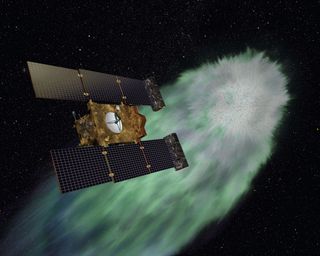When Will Comet Tempel Be Seen Again
FAQ: Inside NASA's Valentine'due south Twenty-four hour period Visit to Comet Tempel 1

On Valentine'due south Solar day (February. 14), NASA'south Stardust-Next spacecraft volition brand a close flyby of comet Tempel 1, zipping to inside simply 124 miles (200 kilometers) of the icy wanderer.
The mission will mark the 2d time a spacecraft has visited two different comets (Stardust's original mission was to the comet Wild 2) during its lifetime. It's also the first fourth dimension two different spacecraft have visited the same comet after years of spaceflight.
NASA's Deep Impact mission sent a spacecraft to rendezvous with comet Tempel 1 in 2005 to intentionally slam a probe into the icy object to look inside the comet. The Deep Touch on spacecraft was later recycled to visit some other comet – Hartley 2 – in 2010.
Hither's a brief overview of the spacecraft and its mission.
Does Stardust-NExT have anything to do with NASA'southward erstwhile Stardust mission?
Yes — it's the same spacecraft with a different mission. NASA's Stardust probe launched back in Feb 1999, tasked with gathering $.25 of dust and gas from around comet Wild two (pronounced "Vilt two") and sending the sample back to World in a return canister.
The original Stardust did its task. It flew by Wild ii in Jan 2004, and the comet material it nerveless made it to Earth two years afterward. Since the probe was still in good shape and had a fair amount of fuel left, NASA gave information technology a new mission in 2007 — to meet up with comet Tempel 1 this year.
Along with that new mission came a new proper name: Stardust-Adjacent (for "Next Exploration of Tempel").
Why Tempel 1? And what does the new mission hope to accomplish?
Another NASA mission, called Deep Impact, visited Tempel 1 back in 2005. But it did more than visit: Deep Impact slammed an impactor into Tempel ane'due south surface, then studied the ejected material to get an thought of what the comet is made of.
Researchers hope Stardust-Next will give them an idea of how Tempel one has changed during this time. They too hope to get a good look at the crater Deep Touch created; the previous mission was non able to see it well, as the huge deject of ejected droppings obscured the new feature.
Another aim is to extend geologic mapping of Tempel 1's surface, adding to the piece of work washed past Deep Touch. Through making these and other observations, Stardust-Side by side can contribute to scientists' understanding of how comets formed at the solar organization'south birth and how they have evolved since then, researchers have said.
How big is Comet Tempel i?
Comet Tempel ane is 3.vii-mile-wide (half dozen kilometers). It completes an orbit every five 1/2 years, so it has circled the dominicus once since Deep Impact'due south visit.
How volition Stardust-NExT fly by the comet?
Stardust-NExT will brand its closest approach to Tempel 1 effectually 11:40 p.chiliad. EST on February. xiv (0440 GMT on Feb. fifteen). At that time, the probe — zooming through space at around 22,400 mph (36,000 kph) — will come within 124 miles (200 km) of the comet, snapping pictures and making measurements all the while.
The probe will accept 72 high-resolution images during the flyby and brainstorm transmitting them to Globe an hour subsequently the closest pass. It will have about 12 hours for all the pictures to reach scientists on the ground, researchers have said.
This NASA video describes the Stardust-Side by side probe'due south Valentine's Day encounter with Comet Tempel 1.
How was Comet Tempel 1 discovered?
Comet Tempel i was discovered onApril 3, 1867 by Ernst Wilhelm Leberecht Tempel of Marseilles, French republic. Because of its periodic nature, 19th-century astronomers kept a close picket on Tempel 1.
They observed its return to the inner solar organization in 1873 and and so once more in 1879, but by 1881 gravitational interactions with other objects had inverse its orbital period to 6 i/2 years. The comet was so "lost" to observers, according to NASA. Attempts to spot it in 1898 and 1905 failed.
In the 1960s, the belatedly comet hunter Brian Marsden studied Tempel 1'southward disappearance and predicted it would render in 1967 and 1972. Indeed, the comet was returned on June 8, 1967, then once more in January 1972.
Tempel i now has the official designation comet 9P/Tempel i. Its orbit has settled into its current 5 1/two-year catamenia and carries the comet between the orbits of Mars and Jupiter.
Is there another comet come across in Stardust-Adjacent's future?
Non likely. The Stardust-Next probe volition burn up almost all of its remaining fuel chasing down Tempel 1, so this will almost certainly exist its final comet encounter mission, researchers have said.
The probe has been a model of reliability and longevity, lasting 12 years in infinite and putting nearly 3.seven billion miles (6 billion km) on its odometer. So if all goes well on Feb. 14, Stardust-Next can drift off into the cold depths of infinite with its head held high.
You tin follow Infinite.com senior writer Mike Wall on Twitter: @michaeldwall.
Join our Infinite Forums to go on talking space on the latest missions, night heaven and more than! And if you lot have a news tip, correction or comment, let united states of america know at: community@space.com.
Source: https://www.space.com/10813-nasa-stardust-comet-tempel1-flyby-faq.html
